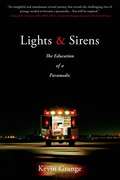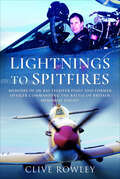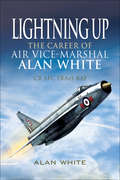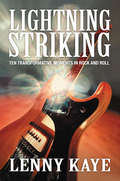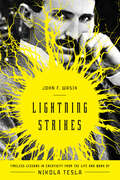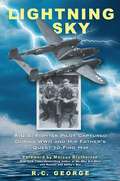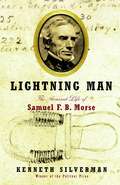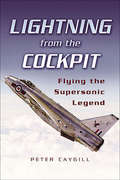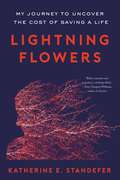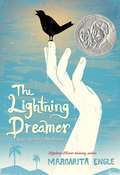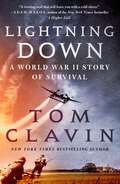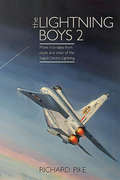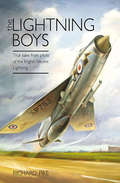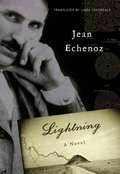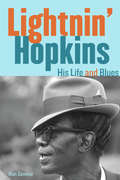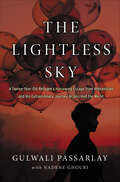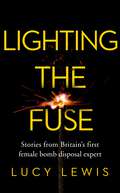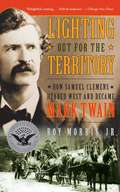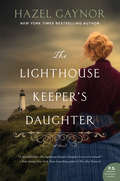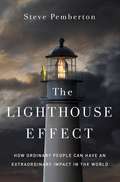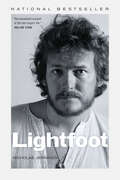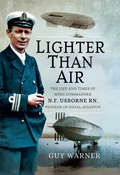- Table View
- List View
Lights and Sirens
by Kevin GrangeA true account of going through UCLA's famed Daniel Freeman Paramedic Program--and practicing emergency medicine on the streets of Los Angeles.Nine months of tying tourniquets and pushing new medications, of IVs, chest compressions, and defibrillator shocks--that was Kevin Grange's initiation into emergency medicine when, at age thirty-six, he enrolled in the "Harvard of paramedic schools": UCLA's Daniel Freeman Paramedic Program, long considered one of the best and most intense paramedic training programs in the world.Few jobs can match the stress, trauma, and drama that a paramedic calls a typical day at the office, and few educational settings can match the pressure and competitiveness of paramedic school. Blending months of classroom instruction with ER rotations and a grueling field internship with the Los Angeles Fire Department, UCLA's paramedic program is like a mix of boot camp and med school. It would turn out to be the hardest thing Grange had ever done--but also the most transformational and inspiring.An in-depth look at the trials and tragedies that paramedic students experience daily, Lights and Sirens is ultimately about the best part of humanity--people working together to help save a human life.
Lights Along the Way: Great Stories of American Faith
by Thomas J. FlemingOur history books are full of important episodes in America's past, and of general biographies of those who have made that history. Rarely do they record, however, how an individual's faith shaped those events. Here, filling in the missing pieces, are thirty-seven portraits of defining moments in American religious history ranging from the Pilgrims to contemporary figures, including: Samuel Sewall, Ben Franklin, George Washington, Johnny Appleseed, Sojourner Truth, Emily Dickinson, Robert E. Lee, Woodrow Wilson, Dorothy Day, Bess Truman, John F. Kennedy, and others.
Lightnings to Spitfires: Memoirs of an RAF Fighter Pilot and Former Officer Commanding the Battle of Britain Memorial Flight
by Clive RowleyA former fighter pilot chronicles his career flying for the Royal Air Force for over four decades in this action-packed memoir. For forty-four years, Clive Rowley flew with the Royal Air Force, and for thirty-one of those years he specialized as an air defense fighter pilot. Such was his love of fast fighter aircraft that, in order to stay flying, he transferred to Specialist Aircrew terms of service, relinquishing any chance of further promotion above his rank of squadron leader. During those years Clive flew Lightnings, Hawks, and Tornado F.3s but, perhaps more intriguingly, for eleven years he flew Hurricanes and Spitfires with the Battle of Britain Memorial Flight (BBMF), the RAF&’s, if not the world&’s most famous &“warbird&” display team, which he ultimately led and commanded. Many readers will have watched him, perhaps unknowingly, as he flew these iconic aircraft, often alongside the Lancaster, at air shows and large-scale commemorations around the UK and Europe. During the Cold War, Clive flew the BAC Lightning from Gütersloh in Germany and in the UK, becoming an expert in the art of air combat in the process. Then for sixteen years he flew the Tornado F.3 as the RAF moved into expeditionary operations. Packed with humorous and often hair-raising anecdotes, but also revealing the shock and sorrow he felt at the deaths of friends and colleagues, this book is a highly detailed account of life as a fighter pilot in the RAF in the last three decades of the twentieth century and into the twenty-first. Clive is open about the fears he sometimes felt in this dangerous world and how he allayed them to continue flying for more than four decades. This book is illustrated with wonderful photographs from his time on the front line as well as with the BBMF, many of which have never been published before. If you have ever wondered what it is like to fly supersonic jet fighters, like the Lightning and the Tornado F.3, or iconic &“warbirds,&” such as the Hurricane and Spitfire, Clive Rowley brings you into those cockpits and shares his experiences.
Lightning Up: The Career of Air Vice-Marshal Alan White CB AFC FRAeS RAF
by Alan WhiteAlan White served in the RAF from 1953 to 1987 roughly the period of the Cold War. His introduction to flying came in his University Air Squadron. This seduced him into dropping out of University and joining the RAF. He initially had success during the piston-engine stages of his training but damage to a Vampire T11 and a bad start on the Hunter Weaponry Course set his confidence back until he recovered during service with his first Hunter Squadron. The infamous Duncan Sandys' cuts of 1957 caused the closure of his squadron and he found himself towing air-to-air gunnery targets, but luckily he was then moved to instruct on the Hunter Operational Conversion Unit where he developed his solo aerobatic display skills. He was then posted to take Hunters to Singapore and form a Squadron. He became involved with the SEATO response to assist the Thai governments request against communist insurgents from Laos and spent five months at Chiang Mai camping in a paddy field. After attending Staff College he was posted to Aden at a time of growing terrorist activity. He worked with the C-in-C, Admiral Sir Michael Le Fanu. Upon his return to the UK he trained to fly the supersonic Lightning fighter and eventually was promoted to lead a squadron. There followed a period of rapid promotion and he became Station Commander at RAF Leuchars. His later appointments as Air Commodore included Director of Operations (Air Defence), Senior Staff Officer HQ 11 Group, Air Commodore Plans at HQ Strike Command (where he assisted in the Falklands conflict) until he was promoted to his final rank and appointed Deputy Commander RAF Germany and then finally he became Commandant, RAF Staff College. His account is full of interesting flying detail and the internal workings of the RAF during those dangerous Cold War days.
Lightning Striking: Ten Transformative Moments in Rock and Roll
by Lenny Kaye“We have performed side-by-side on the global stage through half a century…. In Lightning Striking, Lenny Kaye has illuminated ten facets of the jewel called rock and roll from a uniquely personal and knowledgeable perspective.” –Patti SmithAn insider’s take on the evolution and enduring legacy of the music that rocked the twentieth centuryMemphis, 1954. New Orleans 1957. Philadelphia 1959. Liverpool, 1962. San Francisco 1967. Detroit 1969. New York, 1975. London 1977. Los Angeles 1984 / Norway 1993. Seattle 1991.Rock and roll was birthed in basements and garages, radio stations and dance halls, in cities where unexpected gatherings of artists and audience changed and charged the way music is heard and celebrated, capturing lightning in a bottle. Musician and writer Lenny Kaye explores ten crossroads of time and place that define rock and roll, its unforgettable flashpoints, characters and visionaries, how each generation came to be, how it was discovered by the world. Whether describing Elvis Presley’s Memphis, the Beatles’ Liverpool, Patti Smith’s New York or Kurt Cobain’s Seattle, Lightning Striking reveals the communal energy that creates a scene, a guided tour inside style and performance, to see who’s on stage, along with the movers and shakers, the hustlers and hangers-on, and why everybody is listening. Grandly sweeping and minutely detailed, informed by Kaye’s acclaimed knowledge and experience as a working musician, Lightning Striking is an ear-opening insight into our shared musical and cultural history, a carpet ride of rock and roll’s most influential movements and moments.
Lightning Strikes: Timeless Lessons in Creativity from the Life and Work of Nikola Tesla
by John F. WasikAn exploration of the scientist’s inspiring life, his controversies, his legacy, and how his creativity can help us today.Seventy years after his death, Nikola Tesla has become a rock star. Lightning Strikes examines his complete life and legacy, including Tesla’s profound influence on everything from systems integration to drone warfare. Engineers, entrepreneurs, and academics will find it invaluable not only for the never-before-published interviews and archives, but also for the creative principles that visionaries like Larry Page and Elon Musk have used to build iconic brands and groundbreaking inventions. The book also reveals why the government and business leaders wanted to shut down Tesla’s bold experiments, and how hundreds of his ideas are now being implemented globally—including clean power, robotics, alternating current motors, and wireless transmission of power and information.As a bonus, a free augmented reality app from Yetzer Studio allows you to scan beautiful full-color illustrations in the book, unlocking an interactive 3D animation as well as videos honoring Tesla's life and legacy.
Lightning Sky: A U.S. Fighter Pilot Captured during WWII and His Father's Quest to Find Him
by R.C. GeorgeA U.S. fighter pilot captured by the enemy. A father determined to rescue his son. One of the most remarkable and moving true stories of faith and perseverance to come out of World War II. October 6, 1944. Twenty-year-old Army Air Corps Second Lieutenant David “Mac” Warren MacArthur was on a strafing mission over Greece when a round of 88-mm German anti-aircraft flak turned his P-38 Lightning into a comet of fire and smoke. Dave parachuted to safety as the Lightning lived up to her name and struck the Adriatic Sea like a bolt of flames. In minutes, he was plucked from the water—only to find himself on the wrong end of a German rifle pointing straight at his head. Dave’s father, Lieutenant Colonel Vaughn MacArthur, was a chaplain with the 8th Armored Division of Patton’s Third Army when he learned of his son’s capture. He made it his personal mission to find him. For the duration of the war, as Dave was shuttled from camp to camp—including Dachau—his father never stopped searching. Then in May 1945, Vaughn’s last hope was Stalag VII-A in Moosburg, Germany. Through the barbed wire fence, he cried out his son’s name. Incredibly, out of tens of thousands of POWs, one of them, squinting into the sunlight, turned and smiled. Father and son spent the next two weeks together celebrating, a forever cherished memory. Over the next twenty-five years, Dave would go on to honor his father on rescue missions of his own, becoming a highly decorated and genuine American war hero. In both Korea and Vietnam, Dave would carry with him the legacy of a great man who gave everything to save his son. An inspiring, harrowing, and unforgettable chronicle of love of family and love of country, Lightning Sky is a timeless testament to extraordinary lives in extraordinary times.
Lightning Man: The Accursed Life of Samuel F. B. Morse
by Kenneth SilvermanIn this brilliantly conceived and written biography, Pulitzer Prize winning Kenneth Silverman gives us the long and amazing life of the man eulogized by the New York Herald in 1872 as perhaps the most illustrious American of his age. Silverman presents Samuel Morse in all his complexity. There is the gifted and prolific painter (more than three hundred portraits and larger historical canvases) and pioneer photographer, who gave the first lectures on art in America, became the first Professor of Fine Arts at an American college (New York University), and founded the National Academy of Design. There is the republican idealist, prominent in antebellum politics, who ran for Congress and for mayor of New York. But most important, there is the inventor of the American electromagnetic telegraph, which earned Morse the name Lightning Man and brought him the fame he sought. In these pages, we witness the evolution of the great invention from its inception as an idea to its introduction to the world--an event that astonished Morse's contemporaries and was considered the supreme expression of the country's inventive genius. We see how it transformed commerce, journalism, transportation, military affairs, diplomacy, and the very shape of daily life, ushering in the modern era of communication. But we discover as well that Morse viewed his existence as accursed rather than illustrious, his every achievement seeming to end in loss and defeat: his most ambitious canvases went unsold; his beloved republic imploded into civil war, making it unlivable for him; and the commercial success of the telegraph engulfed him in lawsuits challenging the originality and ownership of his invention. Lightning Man is the first biography of Samuel F. B. Morse in sixty years. It is a revelation of the life of a fascinating and profoundly troubled American genius.
Lightning from the Cockpit: Flying the Supesonic Legend (Aviation Ser.)
by Peter CaygillThe English Electric Lightning was the only single-seat supersonic interceptor fighter designed and manufactured in the UK. It saw service with the RAF in the sixties and seventies and gained a worthy reputation for its speed ( in excess of Mach 2 ) and phenomenal rate of climb. It was, however, a not entirely reliable aeroplane and over fifty were lost during its operational career. In this book, the author has gathered together 16 personal accounts of what it was like to fly the Lightning, thrilling stories that convey the immense brute power of the machine and also its many pitfalls. It will enthrall the enormous following the aircraft still enjoys. Two are now flying in South Africa and four are being restored to flight-worthy condition in the UK. To see a Lightning take off and climb vertically until it vanishes into the sky is one of the most spectacular sights in aviation.
Lightning Flowers: My Journey to Uncover the Cost of Saving a Life
by Katherine E. StandeferLightning Flowers weighs the impact modern medical technology has had on the author's life against the social and environmental costs inevitably incurred by the mining that makes such innovation possible — &“utterly spectacular.&” (Rachel Louise Snyder, author of No Visible Bruises) What if a lifesaving medical device causes loss of life along its supply chain? That's the question Katherine E. Standefer finds herself asking one night after being suddenly shocked by her implanted cardiac defibrillator. In this gripping, intimate memoir about health, illness, and the invisible reverberating effects of our medical system, Standefer recounts the astonishing true story of the rare diagnosis that upended her rugged life in the mountains of Wyoming and sent her tumbling into a fraught maze of cardiology units, dramatic surgeries, and slow, painful recoveries. As her life increasingly comes to revolve around the internal defibrillator freshly wired into her heart, she becomes consumed with questions about the supply chain that allows such an ostensibly miraculous device to exist. So she sets out to trace its materials back to their roots. From the sterile labs of a medical device manufacturer in southern California to the tantalum and tin mines seized by armed groups in the Democratic Republic of the Congo to a nickel and cobalt mine carved out of endemic Madagascar jungle, Lightning Flowers takes us on a global reckoning with the social and environmental costs of a technology that promises to be lifesaving but is, in fact, much more complicated. Deeply personal and sharply reported, Lightning Flowers takes a hard look at technological mythos, healthcare, and our cultural relationship to medical technology, raising important questions about our obligations to one another, and the cost of saving one life.
The Lightning Dreamer: Cuba's Greatest Abolitionist
by Margarita Engle"I find it so easy to forget / that I'm just a girl who is expected / to live / without thoughts." Opposing slavery in Cuba in the nineteenth century was dangerous. The most daring abolitionists were poets who veiled their work in metaphor. Of these, the boldest was Gertrudis Gómez de Avellaneda, nicknamed Tula. In passionate, accessible verses of her own, Engle evokes the voice of this book-loving feminist and abolitionist who bravely resisted an arranged marriage at the age of fourteen, and was ultimately courageous enough to fight against injustice. Historical notes, excerpts, and source notes round out this exceptional tribute.
Lightning Down: A World War II Story of Survival
by Tom ClavinAn American fighter pilot doomed to die in Buchenwald but determined to survive.On August 13, 1944, Joe Moser set off on his forty-fourth combat mission over occupied France. Soon, he would join almost 170 other Allied airmen as prisoners in Buchenwald, one of the most notorious and deadly of Nazi concentration camps. Tom Clavin's Lightning Down tells this largely untold and riveting true story.Moser was just twenty-two years old, a farm boy from Washington State who fell in love with flying. During the War he realized his dream of piloting a P-38 Lightning, one of the most effective weapons the Army Air Corps had against the powerful German Luftwaffe. But on that hot August morning he had to bail out of his damaged, burning plane. Captured immediately, Moser’s journey into hell began.Moser and his courageous comrades from England, Canada, New Zealand, and elsewhere endured the most horrific conditions during their imprisonment... until the day the orders were issued by Hitler himself to execute them. Only a most desperate plan would save them.The page-turning momentum of Lightning Down is like that of a thriller, but the stories of imprisoned and brutalized airmen are true and told in unforgettable detail, led by the distinctly American voice of Joe Moser, who prays every day to be reunited with his family.Lightning Down is a can’t-put-it-down inspiring saga of brave men confronting great evil and great odds against survival.
The Lightning Boys 2: More True Tales from Pilots and Crew of the English Electric Lightning (The\jet Age Ser. #3)
by Richard PikeExciting, first-hand accounts from Lightning aircrews—the sequel to the bestselling book from the author of the Hunter Boys and Phantom Boys volumes.Lightning Boys 2 is a must-have companion to the first collection and continues the theme of tales from pilots and other crew connected with this iconic aircraft, giving a rare insight into postwar fighter operations. In 20 separate stories to intrigue, amaze, and amuse, the book has also been compiled and written by Richard Pike. The reader is taken to situations as diverse as intercepting 60-plus enemy aircraft, a desperate struggle in a cockpit flooded by tropical downpours, the difficulties of being affected by sudden and painful toothache at high altitude, and the curious encounter with an unidentified flying object. Yet another chapter paints a dramatic reconstruction of a scene in Germany when a Lightning, having entered an inadvertent, out-of-control spin, began an earthwards plunge towards a town center.
The Lightning Boys: True Tales from Pilots of the English Electric Lightning (The\jet Age Ser. #3)
by Richard Pike“A good read both to aviators in general and to the Lightning fraternity in particular” (Royal Air Force Historical Society). According to a recent international study, the Lightning is the fifth most popular military aircraft of all time. With over twenty individual stories from former Lightning pilots, this book relates the highs and lows, the dramas and the demands of those who operated this iconic aircraft until its sharp end. Tales include the recollections of an aerobatic display pilot, an implausible yet true account of telepathic communication, and an extraordinary episode in which a Lightning pilot on an exchange program with the French Air Force became embroiled in a mid-air collision. An unverified, but likely genuine, world record is also revealed in one of the chapters. In addition to the original photographs that accompany the text, the renowned aviation artist Chris Stone, a former Lightning pilot himself, has provided a unique sketch as well as copies of some of his paintings, offering a look at this amazing aircraft that will appeal to the general reader as well as the enthusiast.
Lightning
by Jean Echenoz Linda CoverdaleDrawn from the life of Nikola Tesla, one of the greatest inventors of his time,Lightning is a captivating tale of one man's curious fascination with the marvels of science.Hailed by the Washington Post as "the most distinctive voice of his generation," Echenoz traces the notable career of Gregor, a precocious young engineer from Eastern Europe, who travels across the Atlantic at the age of twenty-eight to work alongside Thomas Edison, with whom he later holds a long-lasting rivalry. After his discovery of alternating current, Gregor quickly begins to astound the world with his other brilliant inventions, including everything from radio, radar, and wireless communication to cellular technology, remote control, and the electron microscope.Echenoz gradually reveals the eccentric inner world of a solitary man who holdsa rare gift for imagining devices well before they come into existence. Gregor is a recluse--an odd and enigmatic intellect who avoids women and instead prefers spending hours a day courting pigeons in Central Park.Winner of the IMPAC Dublin Literary Award, Echenoz once again demonstrateshis astonishing abilities as a prose stylist as he vividly captures the life of an isolated genius. A beautifully crafted portrait of a man who prefers the company of lightning in the Colorado desert to that of other human beings, Lightning is a dazzling new work from one of the world's leading contemporary authors.
Lightnin' Hopkins: His Life and Blues
by Alan GovenarBased on scores of interviews with the artist's relatives, friends, lovers, producers, accompanists, managers, and fans, this brilliant biography reveals a man of many layers and contradictions. Following the journey of a musician who left his family's poor cotton farm at age eight carrying only a guitar, the book chronicles his life on the open road playing blues music and doing odd jobs. It debunks the myths surrounding his meetings with Blind Lemon Jefferson and Texas Alexander, his time on a chain gang, his relationships with women, and his lifelong appetite for gambling and drinking. This volume also discusses his hard-to-read personality; whether playing for black audiences in Houston's Third Ward, for white crowds at the Matrix in San Francisco, or in the concert halls of Europe, Sam Hopkins was a musician who poured out his feelings in his songs and knew how to endear himself to his audience--yet it was hard to tell if he was truly sincere, and he appeared to trust no one. Finally, this book moves beyond exploring his personal life and details his entire musical career, from his first recording session in 1946--when he was dubbed Lightnin'--to his appearance on the national charts and his rediscovery by Mack McCormick and Sam Charters in 1959, when his popularity had begun to wane and a second career emerged, playing to white audiences rather than black ones. Overall, this narrative tells the story of an important blues musician who became immensely successful by singing with a searing emotive power about his country roots and the injustices that informed the civil rights era.
The Lightless Sky: A Twelve-Year-Old Refugee's Harrowing Escape from Afghanistan and His Extraordinary Journey Across Half the World
by Gulwali Passarlay Nadene GhouriAn Afghan child refugee chronicles his harrowing journey across the world in this “gripping account of a life-threatening journey to freedom” (Independent, UK).After his father was killed in 2006, Gulwali Passarlay was caught between the Taliban who wanted to recruit him, and the Americans who wanted to use him. To protect her son, Gulwali’s mother sent him away. The search for safety would lead the twelve-year-old across eight countries, from the mountains of eastern Afghanistan through Iran and Europe to Britain. On his yearlong trek, Gulwali endured imprisonment, hunger, cruelty, brutality, loneliness, and terror—and nearly drowned crossing the Mediterranean Sea. Eventually granted asylum in England, Gulwali was sent to a good school, learned English, won a place at a top university, and was chosen to help carry the Olympic Torch in the 2012 London Games. In The Lightless Sky, Gulwali recalls his remarkable experience and offers a firsthand look at the modern refugee crisis.
Lighting Up: How I Stopped Smoking, Drinking and Everything Else I Loved in Life Except Sex
by Susan ShapiroIn the critically acclaimed Five Men Who Broke My Heart, Manhattan journalist Susan Shapiro revisited five self-destructive romances. In her hilarious, illuminating new memoir, Lighting Up, she rejects five self-destructive substances. This difficult quest for clean living starts with Shapiro's shocking revelation that, at forty, her lengthiest, most emotionally satisfying relationship has been with cigarettes. A two-pack-a-day smoker since the age of thirteen, Susan Shapiro quickly discovers that it's impossible to be a writer, a nonsmoker, sane, and slender in the same year. The last time she tried to quit, she gained twenty-three pounds, couldn't concentrate on work, and wanted to kill herself and her husband, Aaron, a TV comedy writer who hates her penchant for puffing away. Yet just as she's about to choose her vice over her marriage vows, she stumbles upon a secret weapon. Dr. Winters, "the James Bond of psychotherapy," is a brilliant but unorthodox addiction specialist, a former chain-smoker himself. Working his weird magic on her psyche, he unravels the roots of her twenty-seven-year compulsion, the same dangerous dependency that has haunted her doctor father, her grandfather, and a pair of eccentric aunts from opposite sides of the family, along with Freud and nearly one in four Americans. Dr. Winters teaches her how to embrace suffering, then proclaims that her months of panic, depression, insecurity, vulnerability, and wild mood swings win her the award for "the worst nicotine withdrawal in the history of the world." Shapiro finally does kick the habit--while losing weight and finding career and connubial bliss--only to discover that the second she's let go of her long-term crutch, she's already replaced it with another fixation. After banishing cigarettes, alcohol, dope, gum, and bread from her day-to-day existence, she conquers all her demons and survives deprivation overload. But relying religiously on Dr. Winters, she soon realizes that the only obsession she has left to quit is him. Never has the battle to stem substance abuse been captured with such wit, sophisticated insight, and candor. Lighting Up is so compulsively readable, it's addictive.
Lighting the Fuse
by Lucy LewisImagine standing over a bomb - you need to make a choice. Remember, your life depends on it.In this extraordinary memoir, Lucy Lewis reveals the hidden world of bomb disposal training and how she came to be the UK's first female bomb disposal expert. From joining Sandhurst to rushing to her first bomb disposal call-out, Lucy's story is full of high stakes and tense situations that for most of us, are beyond comprehension. Lucy's story however is also a deeply inspirational one - joining the military in the 1980s just as women were taking on more dangerous roles, Lucy's every move was watched and scrutinised. This didn't hold her back however, and this is how she broke through the ceiling, fought against sexism and achieved something no woman had ever done before. Lighting the Fuse is an eye-opening memoir, that reveals the hidden world of being a woman in the military and how a young woman with an ordinary background, made history - not just once, but twice.
Lighting the Fuse
by Lucy LewisImagine standing over a bomb - you need to make a choice. Remember, your life depends on it.In this extraordinary memoir, Lucy Lewis reveals the hidden world of bomb disposal training and how she came to be the UK's first female bomb disposal expert. From joining Sandhurst to rushing to her first bomb disposal call-out, Lucy's story is full of high stakes and tense situations that for most of us, are beyond comprehension. Lucy's story however is also a deeply inspirational one - joining the military in the 1980s just as women were taking on more dangerous roles, Lucy's every move was watched and scrutinised. This didn't hold her back however, and this is how she broke through the ceiling, fought against sexism and achieved something no woman had ever done before. Lighting the Fuse is an eye-opening memoir, that reveals the hidden world of being a woman in the military and how a young woman with an ordinary background, made history - not just once, but twice.
Lighting Out for the Territory: How Samuel Clemens Headed West and Became Mark Twain
by Roy Jr. MorrisIn the very last paragraph of Mark Twain's Adventures of Huckleberry Finn, the title character gloomily reckons that it's time "to light out for the Territory ahead of the rest." Tom Sawyer's Aunt Sally is trying to "sivilize" him, and Huck Finn can't stand it--he's been there before. It's a decision Huck's creator already had made, albeit for somewhat different reasons, a quarter of a century earlier. He wasn't even Mark Twain then, but as Huck might have said, "That ain't no matter." With the Civil War spreading across his native Missouri, twenty-five-year-old Samuel Clemens, suddenly out of work as a Mississippi riverboat pilot, gladly accepted his brother Orion's offer to join him in Nevada Territory, far from the crimsoned battlefields of war. A rollicking, hilarious stagecoach journey across the Great Plains and over the Rocky Mountains was just the beginning of a nearly six-year-long odyssey that took Samuel Clemens from St. Joseph, Missouri, to Hawaii, with lengthy stopovers in Virginia City, Nevada, and San Francisco. By the time it was over, he would find himself reborn as Mark Twain, America's best-loved, most influential writer. The "trouble," as he famously promised, had begun. With a pitch-perfect blend of appreciative humor and critical authority, acclaimed literary biographer Roy Morris, Jr., sheds new light on this crucial but still largely unexamined period in Mark Twain's life. Morris carefully sorts fact from fiction--never an easy task when dealing with Twain--to tell the story of a young genius finding his voice in the ramshackle mining camps, boomtowns, and newspaper offices of the wild and woolly West, while the Civil War rages half a continent away. With the frequent help of Twain's own words, Morris follows his subject on a winding journey of selfdiscovery filled with high adventure and low comedy, as Clemens/Twain dodges Indians and gunfighters, receives marriage advice from Brigham Young, burns down a mountain with a frying pan, gets claim-jumped by rival miners, narrowly avoids fighting a duel, hikes across the floor of an active volcano, becomes one of the first white men to try the ancient Hawaiian sport of surfing, and writes his first great literary success, "The Celebrated Jumping Frog of Calaveras County." Lighting Out for the Territory is a fascinating, even inspiring, account of how an unemployed riverboat pilot, would-be Confederate guerrilla, failed prospector, neophyte newspaper reporter, and parttime San Francisco aesthete reinvented himself as America's most famous and beloved writer. It's a good story, and mostly true--with some stretchers thrown in for good measure.
The Lighthouse Keeper's Daughter: A Novel
by Hazel GaynorFrom The New York Times bestselling author of The Girl Who Came Home comes a historical novel inspired by true events, and the extraordinary female lighthouse keepers of the past two hundred years.“They call me a heroine, but I am not deserving of such accolades. I am just an ordinary young woman who did her duty.”1838: Northumberland, England. Longstone Lighthouse on the Farne Islands has been Grace Darling’s home for all of her twenty-two years. When she and her father rescue shipwreck survivors in a furious storm, Grace becomes celebrated throughout England, the subject of poems, ballads, and plays. But far more precious than her unsought fame is the friendship that develops between Grace and a visiting artist. Just as George Emmerson captures Grace with his brushes, she in turn captures his heart.1938: Newport, Rhode Island. Nineteen-years-old and pregnant, Matilda Emmerson has been sent away from Ireland in disgrace. She is to stay with Harriet, a reclusive relative and assistant lighthouse keeper, until her baby is born. A discarded, half-finished portrait opens a window into Matilda’s family history. As a deadly hurricane approaches, two women, living a century apart, will be linked forever by their instinctive acts of courage and love.
The Lighthouse Effect: How Ordinary People Can Have an Extraordinary Impact in the World
by Steve PembertonIn this stirring follow-up to his memoir, Steve Pemberton gives practical encouragement for how you can be a "human lighthouse" for others and through these inspiring stories will renew your hope for humanity. Our polarized, divisive culture seems to be without heroes and role models. We are adrift in a dark sea of disillusionment and distrust and we need "human lighthouses" to give us hope and direct us back to the goodness in each other and in our own hearts. Steve Pemberton found a lighthouse in an ordinary man named John Sykes, his former high school counselor. John gave Steve a safe harbor after Steve escaped an abusive foster home and together they navigated a new path that led to personal and professional success. Through stories of people like John and several others, you will identify how the hardships you have overcome equip you to be a "human lighthouse," inspiring those around you. The humble gestures of kindness that change the course of our lives can shift the course for America too. With a unique vision for building up individuals and communities and restoring trust, The Lighthouse Effect opens your eyes to those who are quietly heroic. You will reflect on the lighthouses in your own life and be reminded that the greatest heroes are alongside us--and within us.
Lightfoot
by Nicholas JenningsThe definitive, full-access story of the life and songs of Canada's legendary troubadourGordon Lightfoot’s name is synonymous with timeless songs about trains and shipwrecks, rivers and highways, lovers and loneliness. His music defined the folk-pop sound of the 1960s and ‘70s, topped charts and sold millions. He is unquestionably Canada’s greatest songwriter, and an international star who has performed on the world’s biggest stages. While Lightfoot’s songs are well known, the man behind them is elusive. He’s never allowed his life to be chronicled in a book—until now.Biographer Nick Jennings has had unprecedented access to the notoriously reticent musician. Lightfoot takes us deep inside the artist’s world, from his idyllic childhood in Orillia, the wild sixties, and his canoe trips into Canada’s North to his heady times atop the music world. Jennings explores the toll that success took on his personal life—including his troubled relationships, his battle with alcohol and his near-death experiences—and the extraordinary drive and tenacity that pulled him through it all.Rich in voices from fellow musicians, close friends, Lightfoot’s family and the singer’s own reminiscences, the biography tells the stories behind some of his best-known love songs, including “Beautiful” and “Song for a Winter’s Night,” as well as the infidelity and divorce that resulted in classics like “Sundown” and “If You Could Read My Mind.” Kris Kristofferson has called Lightfoot’s songs “some of the most beautiful and lasting music of our time.” Lightfoot is an unforgettable portrait of a treasured singer-songwriter, an artist whose work has been covered by everyone from Joni Mitchell, Barbra Streisand and Nico to Bob Dylan, Elvis Presley and Gord Downie. Revealing and insightful, Lightfoot is both an inspiring story of redemption and an exhilarating read.
Lighter Than Air: The Life and Times of Wing Commander N.F. Usborne RN, Pioneer of Naval Aviation
by Guy WarnerNeville Florian Usborne entered the Royal Navy as a cadet in 1897. In the years between him joining up and the outbreak of the First World War, he engaged in a huge number of enterprises and endeavours. Praise and respect garnered in accordance with his achievements all helped to establish his reputation in later years as an 'irreplaceable' pioneer and a leading light of early British airship design. His fertile imagination and enterprising spirit fused to form a dynamic personality, able in wartime to draw up countless schemes in an effort to outwit the enemy. His chief task during the Great War was to dream up new tactics and designs to combat the Zeppelin menace, perceived as one of the most damaging threats of the entire conflict. He was also deeply involved in the design of the very successful SS and Coastal Class airships; indeed, during 1915 he was actually appointed Inspector Commander of Airships at the Admiralty. Unfortunately, his illustrious career was destined to be cut short in 1916 when he was killed testing a prototype of one of his own designs. This new biography seeks to shine a light on an overlooked pioneer of early aviation and it does so in entertaining and reverential style. The importance of Usborne the pioneer is made plain; as one of his contemporaries commented upon his death No one can talk of the early days of British airship design without mention of his name and work. A personality was lost on that February day which was irreplaceable.
